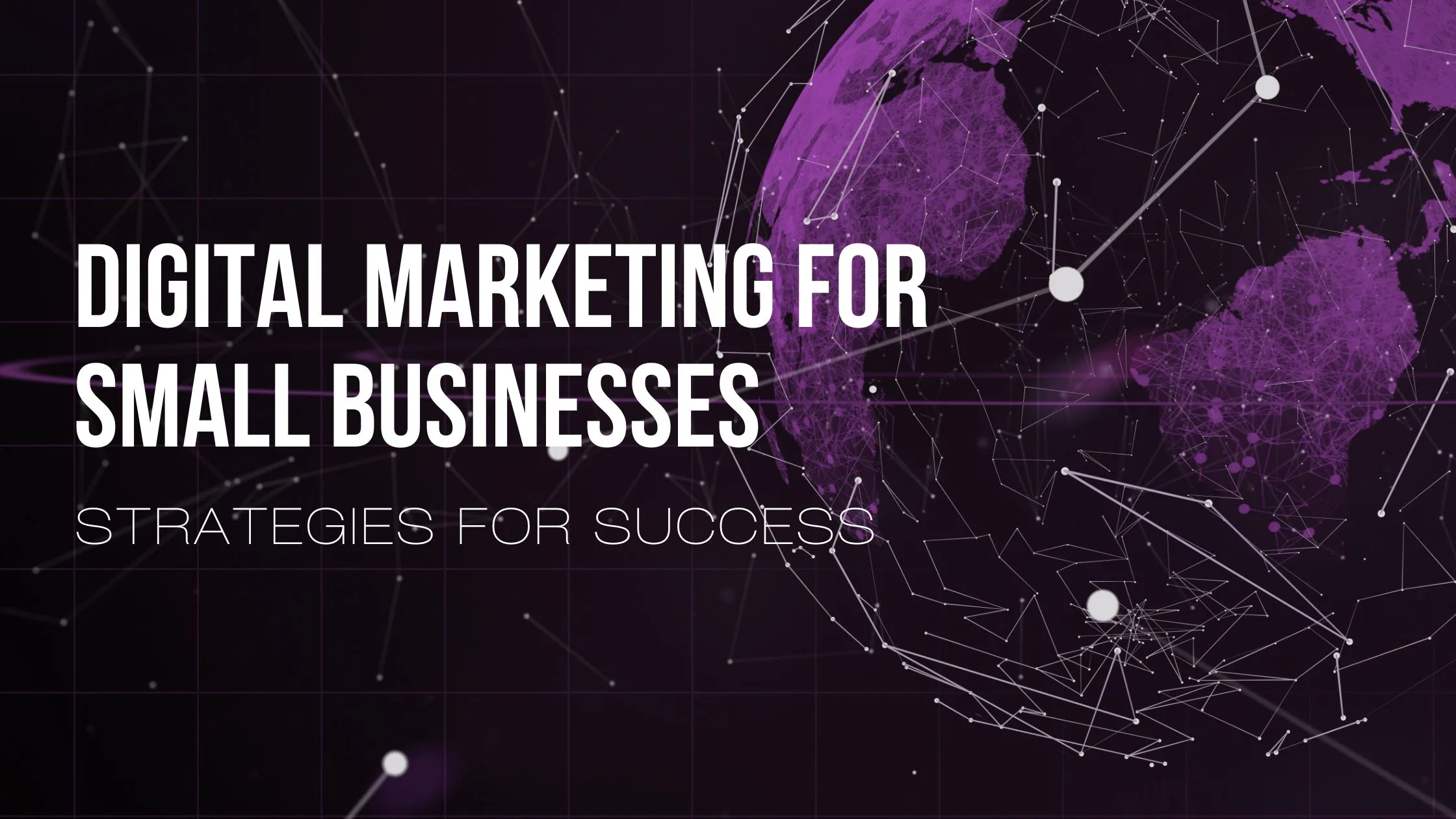Digital Marketing for Small Businesses: Strategies for Success
Are you a small business owner looking to skyrocket your online presence and conquer the digital world? Look no further! In today’s fast-paced, technology-driven era, digital marketing has become an indispensable tool for businesses of all sizes. Whether you’re just starting out or have been in the game for years, this blog post is here to equip you with powerful strategies and expert tips that will help propel your small business towards unrivaled success. Get ready to unleash the potential of small business digital marketing strategy with us!
Introduction to Digital Marketing for Small Businesses
In today’s fast-paced digital world, traditional marketing methods may no longer be enough for small businesses to reach their target audience and stand out among competitors. That is where digital marketing comes in – a powerful tool that can help small businesses expand their online presence, attract new customers, and increase sales.
Digital marketing refers to any form of online marketing efforts or strategies used to promote products or services through various digital channels such as search engines, social media platforms, emails, and websites. It allows small businesses to connect with potential customers on a more personal level and engage with them in real-time.
Benefits of Small Business Digital Marketing
In today’s digital age, having a strong online presence is crucial for the success of any business, especially for small businesses. Digital marketing offers various benefits that can help small businesses reach their target audience, increase brand awareness, and ultimately drive sales. Here are some of the top benefits of digital marketing for small businesses:
1. Cost-effective:
One of the biggest advantages of digital marketing is its cost-effectiveness compared to traditional marketing methods. Small businesses often have limited budgets and resources, making it challenging to compete with larger companies’ advertising efforts. However, with digital marketing techniques such as social media, email marketing, and search engine optimization (SEO), small businesses can reach a large audience at a fraction of the cost.
2. Targeted audience:
Digital marketing allows businesses to target specific demographics based on factors such as location, interests, behavior, and more. This targeted approach helps small businesses ensure that their message reaches the right people who are most likely to be interested in their products or services.
3. Increased brand awareness:
Having a strong online presence through various digital platforms can significantly increase brand awareness for small businesses. With billions of people using social media every day and actively searching for products or services online, digital marketing allows small businesses to get in front of potential customers consistently.
4. Measurable results:
Unlike traditional marketing methods where it’s difficult to measure ROI accurately, digital marketing provides real-time data on campaign performance and results. This allows small businesses to track their progress and make necessary adjustments quickly.
Understanding Your Target Audience
A crucial aspect of successful digital marketing for small businesses is understanding your target audience. No matter how amazing your products or services may be, if you fail to reach the right audience, all of your efforts will go to waste. That’s why it’s important to conduct thorough research and gain a deep understanding of who your target audience is.
Identify Your Ideal Customer
The first step in understanding your target audience is identifying who your ideal customer is. This involves creating a detailed profile that includes their demographics, values, interests, needs, and pain points. Demographics include factors such as age, gender, location, income level, education level etc. while values and interests refer to what motivates them and what they are passionate about.
To create this profile, you can use a combination of data analysis tools such as Google Analytics and surveys or interviews with existing customers. Use these insights to develop buyer personas which are fictional representations of your ideal customers. These personas will guide all of your marketing efforts by helping you understand where and how to reach them effectively.
Understand Their Behavior
Once you have identified who your target audience is, it’s essential to understand their behavior online. This involves knowing which platforms they spend most of their time on (e.g., social media channels), what type of content they engage with (e.g., videos vs written articles), and at what times they are most active online.
Developing a Comprehensive Digital Marketing Plan
Developing a comprehensive digital marketing plan is crucial for the success of any small business in today’s digital landscape. A well-crafted strategy can help you reach your target audience, increase brand awareness, and drive sales. In this section, we will discuss the key steps to developing a comprehensive digital marketing plan.
1. Define Your Goals and Objectives:
The first step in creating a digital marketing plan is to clearly define your goals and objectives. This will serve as the foundation for all other elements of your strategy. Are you looking to increase website traffic, generate leads, or improve brand reputation? Identify specific and measurable goals that align with your overall business objectives.
2. Know Your Target Audience:
Understanding your target audience is vital for any successful marketing campaign. Conduct market research to identify who your ideal customers are, their demographics, interests, and online behavior. This information will help you tailor your messaging and determine which digital channels are most effective in reaching them.
3. Choose the Right Digital Channels:
With so many digital channels available, it can be overwhelming to decide where to focus your efforts. It’s essential to choose platforms that align with both your target audience and business goals. For example, if you’re targeting a younger demographic, social media platforms like Instagram or TikTok may be more effective than email marketing.
Social Media Marketing Strategies for Small Businesses
Social media has become an essential tool for businesses of all sizes, especially small businesses. It allows them to reach a large audience, build brand awareness, and engage with their customers directly. With the right strategies, social media can be a powerful marketing tool for small businesses.
Here are some effective social media marketing strategies that can help small businesses achieve success:
1. Define Your Target Audience:
Before diving into any social media strategy, it is crucial to have a clear understanding of your target audience. This will help you create content and choose the right platforms to reach them effectively. Conduct market research and analyze your current customer base to identify their demographics, interests, and behavior patterns.
2. Choose the Right Platforms:
Not every social media platform is suitable for every business. It is important to choose the ones that align with your target audience and business goals. For example, if you are targeting younger audiences, platforms like Instagram and TikTok may be more effective than Facebook or LinkedIn.
Search Engine Optimization (SEO) Tips for Small Businesses
Search Engine Optimization (SEO) is a crucial aspect of digital marketing and is essential for the success of any small business. It refers to the process of optimizing your website to rank higher in search engine results pages (SERPs) for relevant keywords or phrases. By implementing effective SEO strategies, small businesses can increase their online visibility, attract more organic traffic, and ultimately drive conversions.
Here are some useful SEO tips that small businesses can implement to improve their online presence and stand out from their competitors:
1. Conduct Keyword Research: Keyword research is the foundation of any successful SEO strategy. It involves identifying the words and phrases that your target audience uses when searching for products or services related to your business. Use keyword research tools like Google Keyword Planner or SEMrush to find relevant keywords with high search volume and low competition.
2. Optimize Your Website: To rank higher in search engine results, you need to make sure that your website is optimized for both users and search engines. This includes optimizing meta titles and descriptions, using header tags appropriately, creating unique and high-quality content, adding alt tags to images, improving site speed, and making sure that your website is mobile-friendly.
Email Marketing Best Practices for Small Businesses
Email marketing is a powerful tool for small businesses to reach and engage with their target audience. With the rise of digital marketing, email continues to be one of the most effective ways to communicate with customers and drive sales. However, in order for email marketing to be successful, it’s important to follow best practices that can help your business stand out in a crowded inbox. In this section, we will discuss some key best practices for small businesses when it comes to email marketing.
1. Build a Quality Email List:
The first step towards successful email marketing is building a quality email list. This means collecting emails from individuals who have shown interest in your products or services and have given you permission to contact them via email. Avoid purchasing email lists as they often contain outdated or irrelevant information, which can lead to spam complaints and damage your sender reputation.
2. Segment Your Audience:
Segmentation refers to dividing your subscribers into smaller groups based on shared characteristics such as demographics, location, interests or past interactions with your business. By segmenting your audience, you can send more targeted and personalized emails tailored specifically for each group, resulting in higher open rates and click-through rates.
3. Craft Engaging Subject Lines:
Subject lines are the first thing subscribers see when they receive an email from you, so it’s important to make them attention-grabbing and relevant. A good subject line should entice recipients to open the email while accurately reflecting the content inside.
Paid Advertising Options for Small Businesses
Paid advertising can be a valuable tool for small businesses looking to increase their online presence and reach potential customers. With the rise of digital marketing, there are now multiple options available for small businesses to advertise their products or services online. In this section, we will explore some of the most effective paid advertising options for small businesses.
1. Search Engine Advertising:
Search engine advertising, also known as pay-per-click (PPC) advertising, is one of the most popular forms of paid advertising for small businesses. This involves bidding on keywords related to your business and paying each time someone clicks on your ad in search engine results pages (SERPs). Google AdWords and Bing Ads are two of the most widely used platforms for search engine advertising.
One of the main advantages of search engine advertising is that it allows you to target specific keywords relevant to your business, making it more likely for your ad to be seen by potential customers who are actively searching for your products or services. It also offers a high level of control over budget and targeting options, allowing you to set a daily budget and choose specific demographics, locations, and devices to show your ads.
2. Social Media Advertising:
With billions of users worldwide, social media platforms like Facebook, Instagram, Twitter, and LinkedIn offer an immense opportunity for small businesses to reach their target audience through paid advertising. These platforms allow you to create highly targeted ads based on demographics such as age, location, interests, behaviors and even job titles.
Measuring and Analyzing Your Small Business Digital Marketing Strategy
Measuring and analyzing your digital marketing efforts is crucial for the success of any small business. Without proper tracking and analysis, it can be difficult to determine the effectiveness of your strategies and make necessary adjustments to improve your results. In this section, we will discuss the important steps you need to take in order to measure and analyze your digital marketing efforts.
1. Set Clear Goals: Before you start measuring anything, it is important to have a clear understanding of what you want to achieve with your digital marketing efforts. Whether it is increasing website traffic, generating leads, or improving brand awareness, having specific goals will help you determine which metrics are most relevant for tracking progress towards these goals.
2. Use Analytics Tools: There are various analytics tools available that can help you track and measure different aspects of your digital marketing efforts. Google Analytics is one of the most popular tools that provides valuable insights into website traffic, user behavior, conversions, and more. Social media platforms also offer their own analytics tools that can provide data on engagement, reach, and other metrics.
3. Track Key Performance Indicators (KPIs): KPIs are specific metrics that indicate how well your digital marketing efforts are performing against your goals. These could include website traffic, click-through rates (CTR), conversion rates, cost per lead/customer acquisition costs (CPA), social media engagement rates, etc. Identify the most relevant KPIs based on your goals and track them regularly to monitor progress.
Common Mistakes to Avoid in Digital Marketing for Small Businesses
Digital marketing has become an essential aspect of business growth in today’s digital age. With the rise of social media, online shopping, and virtual interactions, small businesses can no longer rely solely on traditional marketing tactics to reach their target audience. However, with this shift towards digital marketing comes a learning curve, and many small businesses make mistakes that can hinder their success. In this section, we will discuss some common mistakes that small businesses should avoid when it comes to digital marketing.
1. Not Defining Your Target Audience: One of the biggest mistakes small businesses make is not defining their target audience clearly. Without a clear understanding of who your ideal customer is, it becomes challenging to create effective marketing campaigns that resonate with them. It is crucial to conduct market research and gather data on your audience’s demographics, interests, and behaviors to create targeted content that appeals to them.
2. Neglecting Search Engine Optimization (SEO): SEO plays a significant role in driving traffic to your website and improving your search engine rankings. Many small businesses neglect SEO because they do not understand its importance or find it too technical for their expertise level. However, ignoring SEO means missing out on potential customers who are searching for products or services similar to yours online.
Conclusion:
In today’s digital age, having a strong online presence is crucial for the success of any small business. With the rise of social media and e-commerce, more and more consumers are turning to the internet to research products and services before making a purchase. This makes it imperative for small businesses to have an effective digital marketing strategy in place.





